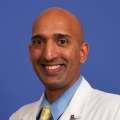Patients with sleep disorders can sometimes search for years before receiving a correct diagnosis or effective treatment. “There’s a significant shortage of sleep medicine physicians nationwide, and access to a competent, knowledgeable clinician can be challenging,” notes Ravi Aysola, MD, chief of sleep medicine in UCLA’s Division of Pulmonary, Critical Care and Sleep Medicine and director of the UCLA Sleep Center.
UCLA Health offers options for such patients that are not available at many other centers. With its state-of-the-art sleep lab and more than 20 board-qualified sleep medicine physicians, UCLA Health’s practice is among the largest in the country. Its practitioners represent a broad range of specialties, including neurology, psychiatry, pulmonology, otolaryngology and oral-maxillofacial surgery. They also include faculty members whose focus is primarily on research, providing a conduit to clinical trials and cutting-edge therapies for patients with more esoteric or poorly understood disorders.
The UCLA Sleep Center’s mission “is to educate and empower our patients, and to provide the highest level of care.”
In addition, the sleep center is aligned with the UCLA Insomnia Clinic in the Department of Psychiatry and Biobehavioral Sciences, which focuses on nonpharmacologic methods to manage chronic insomnia. First-line cognitive behavioral therapy for insomnia and mindfulness-based therapy for insomnia are the treatment strategies employed to help patients manage chronic insomnia, which often overlaps with and aggravates other sleep disorders. "The UCLA Insomnia Clinic is a critical part of the UCLA Sleep Medicine team and enables us to comprehensively address our patients’ sleep disorders," Dr. Aysola says.
Sleep medicine is a complex specialty, involving both adult and pediatric patients, and covering more than 80 disorders, from parasomnias (conditions characterized by disruptive behaviors during sleep) to ailments involving excessive wakefulness, excessive sleepiness, abnormal timing of the sleep-wake cycle or problems with breathing during sleep. These disorders may occur in the absence of clear underlying causes, or they may arise from other diseases.
For example, “In my practice, I take care of a lot of patients with muscular dystrophies,” Dr. Aysola says. “Treating their sleep-disordered breathing poses different challenges from those of more common forms of sleep apnea.”
For patients with a parasomnia, differential diagnosis is often crucial — for example, determining whether an individual’s nocturnal flailing results from abnormal muscle activity during rapid eye movement sleep (as in a condition called rapid eye movement sleep behavior disorder, or RBD), from an autonomic response to apneic episodes, from seizures or from some other cause.
“It can be a gray area,” Dr. Aysola says. “I’ve had patients who flailed in their sleep and broke a window or broke a piece of glass around the bed. They’d say, ‘I had this dream, and I was fighting, and then all of a sudden, my partner said I threw my arm at them or accidentally broke something.’” It sounds like it could be RBD, Dr. Aysola says, but then a sleep study reveals that episodes of apnea are actually triggering their actions.
That is why “it’s crucial to stay current with the latest basic and clinical science, as well as evolving diagnostic criteria and therapeutic modalities,” Dr. Aysola says. “Our clinicians are all engaged in ongoing education, and we attend national professional meetings year-round to keep up with developments in our respective fields.”
The UCLA Sleep Center’s mission, he adds, “is to educate and empower our patients, and to provide the highest level of care by practicing evidence-based medicine and engaging in continuous quality improvement. We are fortunate to have an exceptional group of physicians who excel at the bedside practice of medicine, as well as at education, research and developing new therapies,” Dr. Aysola says. “Medicine truly is a team sport, and the strength of our center is our team.”

